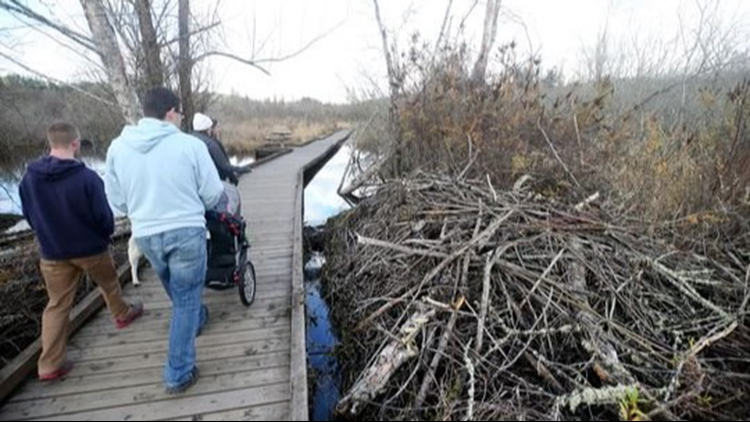On a wooded stretch of Barker Creek, where the stream meanders past a churchyard, water pools behind a dam not built by human hands.
Beavers are busy throughout the soggy gully. Tidy stacks of gnawed sticks divert the flow of water in places, creating sprawling ponds. The stream banks are littered with fallen trees, and the trunks of still-standing cedars have been chewed nearly in half.
In places like Barker, and other creeks across the county, stream-watchers have noticed an uptick in beaver activity this year, raising concern among some observers that the natural barriers could block fish passages. A dry start to the fall kept water levels low in many creeks, slowing the progress of salmon to spawning grounds and making the beaver dams even more noticeable.
"We get tons of calls from people saying there's a beaver dam and they're concerned about the fish," state Department of Fish and Wildlife habitat biologist Brittany Gordon said.
While dams can, in some instances, impede fish, Gordon said the rodents do more to help than hinder salmon.
Structures engineered by beavers create complex habitat for fish and other wildlife by slowing water flow, funneling water into deep pools and fast-moving side channels, and connecting isolated wetlands. Such diverse habitat is especially critical for juvenile coho salmon, which will spend a year in freshwater before migrating into the ocean.
"They need places to hide, places to eat and places to get big," Gordon said. "they need ponds and slower-moving areas."
When there's enough water in creeks for salmon to spawn, the returning fish are adept at getting over and around beaver dams, as they have for time immemorial. A series of small dams can make it easier for salmon to splash upstream by holding standing water.
Gordon said dams do sometimes impede fish during very dry periods and when they are built up against human infrastructure like culverts. Even when streams are low, it's a bad idea to bust up dams, Suquamish Tribe biologist Jon Oleyar said.
"Please know that you are not doing the fish any favors by breaking a hole in these dams," Oleyar said in a recent email.
Notching a dam during spawning season can send a sudden "pulse" of water downstream, giving salmon a false signal that it's time to move upstream. Water levels will drop above the busted dam, potentially stranding fish.
"There is no winner," Oleyar said.
Gordon said the Department of Fish and Wildlife advocates keeping dams in place whenever possible.
"The habitat benefits that dams provide outweigh any temporary barriers," she said.
Modifying a beaver dam requires a state hydraulic project permit. Property owners can also have beavers trapped and removed if they follow trapping regulations.
Beaver dams are most often removed when they flood roads and damage property. A quick search of a state database showed about 20 hydraulic project permits had been issued for dam modification or removal since 2014.
Fish and Wildlife has several times notched dams on streams flowing into Hood Canal to improve fish passages. Gordon said those modifications were made to aid Hood Canal summer chum, which are listed as "threatened" under the Endangered Species Act and return to spawn in late summer when water levels in creeks are very low.
"When beaver dams are low in the watershed, our fish biologists may notch the dams to help these fish out," she said.
In many other cases, Kitsap County has applied to remove or notch dams in places where roads and trails are flooding. Particularly tenacious beavers in Kingston have for years thwarted attempts to keep them from blocking a culvert under 288th Street, near the head of Port Gamble Bay. The county applied for an emergency permit in November to once again sweep away a dam there.
Back on Barker Creek, a private property owner has called attention to flooding caused by the beaver dams and a lack of salmon spawning above the dams. The owner has been in contact with the county, which owns the parcel where the most recent beaver dams were built, as well as Fish and Wildlife officials. No hydraulic permits had been filed for the site as of last week.
One of the most visible beaver dams in Kitsap flanks both sides of a boardwalk on the Clear Creek Trail, west of Schold Road. Mary Earl with the Clear Creek Task Force said beavers have dropped trees and erected dams at several spots along the creek since 2010, keeping county workers and volunteers on their toes.
A pipe was installed in 2016 to allow water to drain out of a beaver pond and prevent the boardwalk from flooding. Fencing has been strung around the base of dozens of tree trunks to protect them from beaver teeth.
Earl said the boardwalk has so far remained dry and task force members are keeping an eye on the water levels. The beaver, meanwhile, "continue to work at restoring the wetlands at no charge to the taxpayer."



